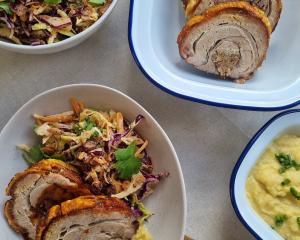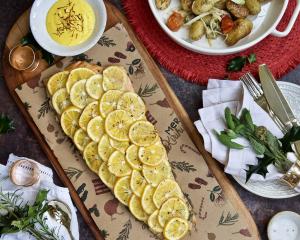From delicious pork and shrimp dumplings to stinky tofu, from beef noodle soup to iron eggs, Charmian Smith savours some of the culinary delights of Taiwan.
The bustle and aromas of Taiwanese night markets assail your senses as you weave between people cooking and eating with gusto. Each of the many stalls has its own specialties: sweet potato balls with quail eggs inside, strips of turkey served over rice with pickled turnip, a dark bean soup that looks like chocolate but tastes quite different, flat shrimp cakes, every bit of the pig cooked in numerous ways, beef noodle soup, red-cooked duck, whole spanking-fresh fish, shiny, dark and chewy "iron eggs" and lots of vegetables and fruit.
Announcing its presence with a distinctive aroma not unlike strong body odour mixed with pungent blue cheese, the infamous stinky tofu was being grilled on several stalls.
Fermented tofu, brushed with barbecue or other spicy sauce, grilled and served with pickled cabbage, is surprisingly good - once you've got past the smell.
It's a favourite with a lot of locals and I think I could develop a taste for it, too.
Night markets which set up in streets in cities and towns around Taiwan are famous for serving traditional foods and snacks. They are crowded with locals tucking into the various delicacies and tourists taking photographs and gingerly trying a few titbits. You can wander among the stalls, selecting your own vegetables to be poached in a flavoursome stock or grilled over charcoal, or choose some unfamiliar part of an animal, or just luxuriate in a hearty bowl of spicy noodle soup - the famous Taiwanese beef noodle soup with pickled mustard greens and other vegetables is delicious. And to finish, there's fresh tropical and subtropical fruit.
Taiwanese food has its origins in Zhejiang and Jiangsu provinces, according to Dr Joe Wang of the Government Information Office, which hosted our group of foreign journalists from the US, Canada, Slovenia, South Africa and New Zealand.
Both Zhejiang and Jiangsu cuisines are known for their emphasis on fresh seasonal produce and soft or tender textures. However, there are culinary legacies from others - colonising Japanese in the first half of the 20th century, 400 years of Chinese immigration - especially Chinese fleeing from communist China after World War 2 bringing many other regional cuisines with them - growing globalisation, and, perhaps most significantly, the produce of this fertile tropical and subtropical island with its generous rainfall, surrounded by teeming seas.
The indigenous Taiwanese people's cuisine is more rustic - millet was their staple instead of rice, and they were good hunters and gatherers, barbecuing their catch and eating wild plants and greens, depending on their tribal traditions.
There's also a strong vegetarian culture in Taiwan, and the many vegetarian restaurants are a legacy of Buddhism, one of the country's major religions. A vegetarian in our group always luxuriated in an array of special dishes brought out specially for him, from tofu, dried bean curd and "vegetarian" pork, to vegetable-filled dumplings and many types of mushroom and other vegetable dishes.
From our base in Taipei, Dr Wang took us through the 13km Snow Mountain tunnel to Yilan on the east coast, where the rainy, fertile alluvial Langyang Plain is bordered on three sides by high forested mountains and on the fourth by the Pacific Ocean.
At first I thought the whole plain was built up, but it seems the farmers have smallholdings of a few hectares, and many have built new houses which makes the countryside look unfamiliarly crowded - at least to a New Zealander's eyes.
At the beginning of winter, many of the rice paddies were flooded and only distinguishable from the fish farms by the water wheels aerating the latter. Among the houses, vegetable gardens and small orchards filled every other available space. In summer, they grow watermelons on the sandy river banks and, in winter, out-of-season vegetables at the edge of the many hot springs in this volcanic region.
Yilan's natural springs are a source of much of the country's bottled water, and also of the water used in the giant King Car Kavalan whisky distillery. Built in 2005 and releasing its first, widely acclaimed whisky in 2008, it now receives a million visitors a year (more than 5000 a day at weekends) and produces up to nine million bottles a year. Made in stills imported from Scotland, its single-malt whiskies are floral with overtones of sweet tropical fruits, which appeal to the local palate. Whisky matures faster in the warm, humid climate of Yilan and they say three to four years will be the equivalent of 10-12 in the cold, damp climate of Scotland. Interestingly, instead of feeding the draff (spent grains from the distilling process) to cattle, they use it to make very palatable high-fibre crackers.
Local produce is prized and restaurants are proud to serve fish from a neighbouring pond, pork and chicken are raised nearby and vegetables and fruit grown just down the road.
Wild Smoke, in a high valley in the surrounding mountains, took this to its logical conclusion, serving whatever they had picked or caught that day - there was no choice but a big selection of dishes. It also made superb Taiwanese-grown coffee, which they roast themselves, with a hint of earthiness.
Platters of fruit often finish a meal - guava, golden starfruit, bright red dragonfruit with white flesh dotted with tiny black seeds, many types of citrus, apples and small sweet tomatoes. Fruit is often sprinkled with a little salty-sour-sweet plum powder, an unusual but delicious seasoning.
To drink, there is fresh juice, sometimes slightly salted, from starfruit, local mandarins or tiny, juicy cumquats the size of small eggs.
You eat cumquats whole, skin and all, for a delicious burst of tangy sweetness.
One of the culinary highlights of the trip was a meal at Din Tai Fung, a dumpling restaurant in the basement of Taipei 101, said to be the world's second-tallest building. Din Tai Fung started in Taiwan but is now an international chain of dumpling restaurants stretching from the US to Australia - the Hong Kong branches have been awarded a Michelin star and named as one of the top 10 restaurants in the world by the New York Times.
Through windows inside the busy restaurant you can see rows of chefs meticulously filling and folding dumplings. These soon turn up on your table, exquisitely pleated, steamed and bursting with juice and flavour when you bite into them. The secret to getting a sauce or jus into the dumpling is to use a jellied stock, I was told.
There are numerous flavours and shapes - pork, shrimp, vegetable, fish, crab in many combinations and, of course, vegetarian ones like taro or mushroom. To eat them you simply pick up the dumpling with chopsticks, dip it into a mix of soy sauce, vinegar, and fine shreds of ginger and bite into it. Delicious!
• Charmian Smith travelled to Taiwan as a guest of the Taiwan Government Information Office.
Eggs with a spicy twist
Tamsui, a former fishing village and port near the mouth of the Tamsui River, is now a suburb of Taipei, but retains some of its original charm in old Gongming St and surrounding alley markets.
One of the local specialties is "iron eggs" which look like shiny black olives. Quail eggs, cooked in a spicy soy marinade, are repeatedly dried and recooked until they are hard, chewy and delicious.
The white becomes black and rubbery and the yolk chewy.
They are sweet, spicy and slightly salty with a concentrated egg flavour - a great snack with drinks.
I brought some back, but, alas, Maf wouldn't let even well-cooked, vacuum-packed eggs come into the country.
So I decided to try them myself, using hen eggs as quail eggs are hard to come by here.
I hard-boiled and peeled a dozen small eggs and made a marinade by cooking 100g of sugar (brown and white mixed), 4-6 Tbsp dark soy sauce and spices - a star anise, a teaspoon of crushed allspice and black pepper (or you could use Chinese five-spice powder) - until melted. Then I turned the peeled eggs in the marinade and simmered them over low heat for about 30 minutes.
Then they had to be dried on a rack for 30-40 minutes, and returned to the hot marinade to simmer another 30 minutes.
It's said you repeat this eight to 10 times, but the skins became leathery and shrank during the first cooking, and I found that during the third cooking a couple of the eggs burst so I stopped there.
They had dark brown skins and a good flavour, but did not look as attractive as the lovely shiny Tamsui quail "iron eggs".











